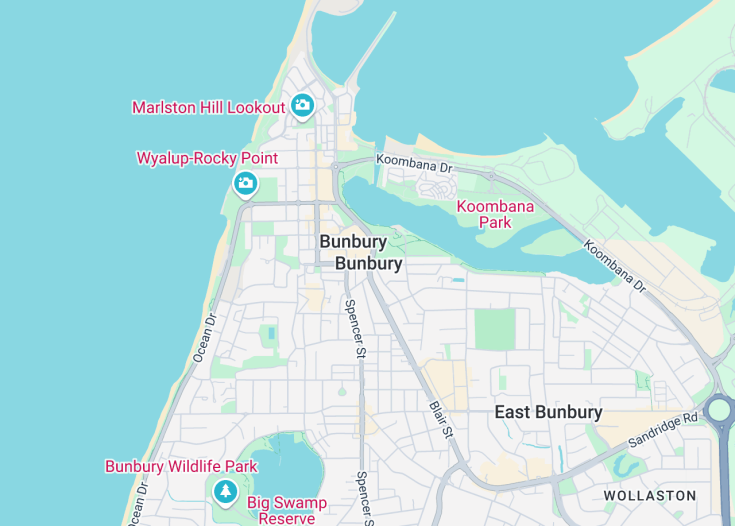Bunbury, a vibrant coastal city in Western Australia, offers a unique blend of charming countryside and bustling urban landscapes. Nestled on a peninsula, it is flanked by the Indian Ocean, Koombana Bay, and the Leschenault Inlet. Known for its beautiful beaches, Bunbury is a paradise for water sports enthusiasts and nature lovers alike.
The city is also renowned for its cultural scene, featuring an array of arts and entertainment options. With its mild climate and welcoming community, Bunbury serves as an ideal destination for those seeking both adventure and tranquility.
Enhance your Bunbury visit by exploring its extensive bike trails—ideal for capturing scenic views and local wildlife.
Don’t miss visiting the Dolphin Discovery Centre, where you can interact closely with dolphins in their natural habitat.
Top things to do & see in Bunbury
Select the following sights and activities to discover best tickets and tours available in Bunbury.
Bunbury: A Coastal Gem in Western Australia
| Country | Australia |
| Time in Bunbury | GMT+8 |
| Language spoken | English |
| Population | 31,000 (source: latest census data) |
| Currency | Australian Dollar (AUD $) |
| Airports |
|
Bunbury is an enticing coastal city located in the southwestern part of Western Australia. Known as a port city, Bunbury is enveloped by blue waters from the Indian Ocean, lush green forests, and an enchanting dolphin population in the bay. Historically, it was established in 1836 and has since evolved into a vibrant community with a rich blend of culture, history, and nature.
With a population of around 31,000 residents, Bunbury serves as a crucial hub for the surrounding agricultural and mining regions. The lifestyle here is relaxed and inviting, making it a popular destination for both tourists and locals seeking a serene escape with the convenience of urban amenities.
Where is Bunbury?
Bunbury is situated approximately 109 miles (175 km) south of Perth in Western Australia, nestled on the shores of the vast Indian Ocean.
Distances:
| Route | Distance by car | Time by car |
|---|---|---|
| Perth to Bunbury | 109 mi / 175 km | 2 hours |
| Margaret River to Bunbury | 55 mi / 88.5 km | 1 hour |
What is Bunbury famous for?
Bunbury is renowned for its spectacular dolphin encounters at Koombana Bay, its vibrant cultural scene which includes art galleries, theatre, and annual festivals, and its beautiful beaches that offer a perfect backdrop for water sports and relaxation.
History
Pre-European Settlement
The area now known as Bunbury has been inhabited for thousands of years by the Indigenous Noongar people. This region, part of the larger Noongar country, was referred to as ‘Bunbury’ long before European contact, deriving from ‘Bunbarian’, a place of the first light. The indigenous people used the vast natural resources, especially the ocean and the estuary, for fishing, hunting, and gathering.
1836 – Early European Exploration
European exploration of the Bunbury area began in 1836 when Lieutenant Henry William St Pierre Bunbury arrived, after whom the city was later named. Initial settlers were drawn by the rich soil and the potential for agricultural development. By the mid-19th century, a small settlement had formed, primarily supported by timber and agriculture.
1900s – Industrial Development
The early 20th century marked a period of significant growth for Bunbury due to the expansion of the local industry, particularly in timber and farming. The port of Bunbury became increasingly vital, facilitating the export of goods such as timber, wool, and later, mineral sands. The city’s infrastructure grew, with roads, rail connections, and public buildings being constructed, reflecting its importance in Australia’s trade networks.
1970s – Present: Modernization and Diversification
Post-1970, Bunbury saw a diversification of its economy with developments in the retail sector, tourism, and mining. The city embraced modernization while maintaining its local charm and historical sites. Today, Bunbury is a bustling urban center known for its vibrant culture, arts, and a growing focus on sustainable development practices that leverage its unique coastal and forest environments.
Visit Bunbury
What to see and do in Bunbury
Explore the natural beauty and urban charm of Bunbury, offering attractions for nature lovers, history enthusiasts, and cultural aficionados alike. The highlights include:
- Koombana Bay: Ideal for swimming, dolphin watching, and relaxing by the beach.
- Bunbury Wildlife Park: Engage with native Australian animals in a well-maintained facility.
- Marlston Hill Lookout Tower: Offers panoramic views of Bunbury’s cityscape and coastline.
- Bunbury Museum and Heritage Centre: Discover the city’s rich history from Indigenous culture to contemporary times.
Additionally, Bunbury’s vibrant café scene and local art galleries provide a taste of local urban culture, making it an enriching experience for every visitor.
Festive Times in Bunbury
Bunbury comes alive with various annual events that celebrate its rich culture and community spirit. Key events include the Bunbury Festival, held in March, featuring music, art, and dance; and the Bunbury Show, a traditional agricultural and produce exhibition taking place each April. These events, among others throughout the year, offer a perfect snapshot of community life in Bunbury.
Best time to visit Bunbury
The best time to visit Bunbury is from September to April when the weather is warm and conducive for outdoor activities. This period also aligns with many of the city’s cultural events and festivals, providing visitors with an extensive taste of local life and entertainment.
Is Bunbury worth visiting?
Bunbury is undoubtedly worth visiting for those who appreciate a blend of natural beauty and local culture. The city offers bountiful opportunities for outdoor activities including beach outings, wildlife encounters, and scenic views from historical sites.
However, it might be seen as quiet or less bustling compared to major cities, which could be a drawback for those seeking a more vibrant urban experience. Nonetheless, its charm, coupled with the friendly community and slower pace, provides a refreshing escape from the hustle of metropolitan areas.










